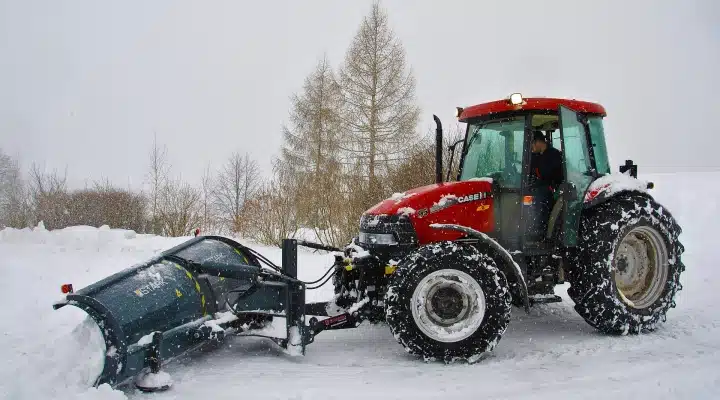The winter season brings unique challenges for farmers and those who depend on tractors. They must overcome them if they want to keep their machines operating efficiently under winter conditions. These conditions, such as the biting cold, snow-covered fields, and frozen ground, can put a strain on tractor.
They can also compromise safety and efficiency while operating these machines. Nevertheless, if you make proper preparations and take precautions, your tractor will stay reliable. Your tractor will continue to serve the same purpose for your agricultural activities this winter by adding a bit of the art of surviving in winter to it.
Essential Winter Tractor Maintenance:
Perform a detailed summarisation inspection to ensure your chosen tractor functions well in cold weather. This should be done at a specific time, precisely when the very first snowflakes fall onto the ground. This involves inspecting and maintaining various components to ensure they can withstand the frigid temperatures and continue functioning seamlessly.
Engine Oil and Coolant for Tractor:
Change to winter-specific engine oil and radiator fluid for your tractors that will guard against freezing of the engine while keeping it protected. Specialised fluids for proper lubrication and circulation keep up the top-notch engine functioning despite the mercury plunging down the zero point.
Battery:
Your batteries, when tested, are charged and have cranking power that starts up your tractor when it’s cold. If the battery seems weak or close to being spent, think about replacing it. Lastly, battery blankets or warmers should be used if possible as they also help to increase the battery’s longevity.
Fuel System:
Add anti-gel additives so as to eliminate fuel-gelling. This occurrence happens when the paraffin wax in diesel fuel hardens at a lower temperature. It forms ice blockages in fuel lines and filters. The additives reduce the pour point of fuel so that liquid can be moved at the lowest temperatures.
Tires:
Make sure that your tractor tyre are well-inflated for a good grip in snowy and icy conditions. Regularly check the tire pressure and make compensations to the extent of any changes due to temperature fluctuations. When in very slippery terrain, consider using tire chains as additional grips.
Starting Your Tractor in Cold Weather:
Starting your tractor in cold weather can be a challenge, but with the right approach, you can minimise the risk of damage and ensure a smooth start:
Park in a Warm Place: Protecting your tractor from the adverse effects of weather.
It is recommended that you store your tractor in a heated garage or barn, as this will ensure it remains protected against the harsh cold conditions. This environment will be warmer, and therefore, it will be easy for the engine to start by itself, and the parts will not freeze or seize.
Use an Engine Block Heater: A warm embrace for your engine.
Therefore, an engine block heater warms up the engine oil as this helps reduce its viscosity, in turn making the engine crank easily (CARPROUTON, 2015). The simple but functional unit raises cold starts considerably, and most notably, it can improve cold starts even in subzero temperatures.
Give the Engine Time to Warm Up:
Run the engine on idle for a few minutes before loading it. This allows enough time for the oil to move adequately so that it provides sufficient lubrication and prevents wear and tear of the engine’s inside parts.
Operating Your Tractor in Winter Conditions:
Once your tractor is started and warmed up, it’s essential to operate it safely and efficiently in the challenging conditions of winter:
Take it Slow: Drive slowly, and do not make sudden brakes or drastic bends when driving on wet roads, as you may lose control. Tractor driving in slippery conditions requires a more careful, slow and steady manner.
Clear Snow and Debris: Remove snow and other debris from working areas so that your tractor and its attachments will not be damaged before you start operating it. Snow plus other debris may clog up a filter, block vision, or serve as an obstacle on a road.
Be Mindful of Hydraulics: Hydraulic fluids are thicker in the cold, which reduces their efficiency. Run hydraulic attachments slowly so that fluid can respond and avoid abrupt motions.
Avoid Overworking the Engine: Working under extreme cold weather places more demand on the engine in terms of higher force to overcome greater pressure and sufficient lubrication. Do not strain the engine; stop when necessary before overheats and damage to your engine sets in.
Lubricate Attachments
Use grease or lubricants on moving parts of attachments in order not to allow for corrosion that may hinder smooth operation.
Protect Electrical Components
Insulate electrical components in the attachments from rain, snow, and other kinds of rubbish.
Store Attachments Properly
Cover indoor attachments or store outside, shielded from the weather.
Additional Tips
Ensure that you have a first-aid kit as well as emergency supplies in your tractor’s cab.
- When it comes to winter conditions, dress well with warm clothing such as gloves, boots, and hats.
- Ensure you are vigilant and cautious enough and look out for dangerous spots like snow drifts and ice pieces.
- Try to take breaks so that you do not get tired and remain alert.
Therefore, by adhering to the above guidelines, you will prepare your tractor loan to face winter challenges. Remember, how you maintain your tractor loan determines its longevity and faithful service as a crucial part of your farm machine workforce.
